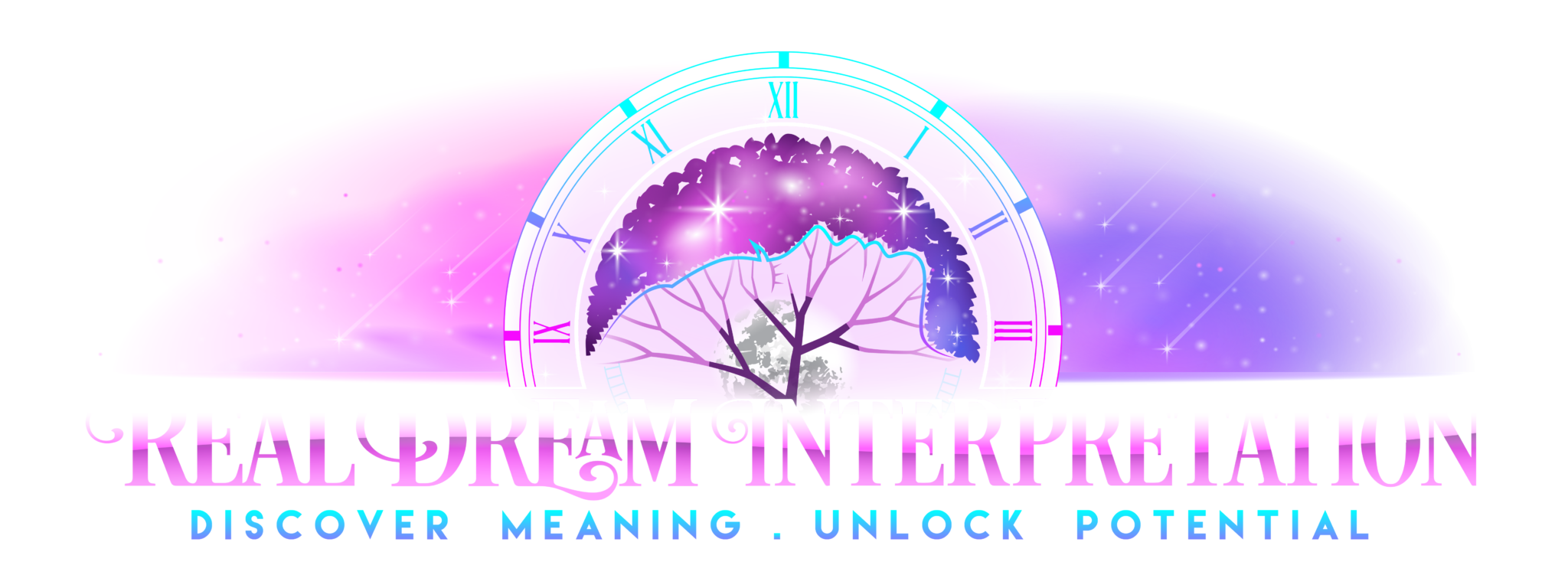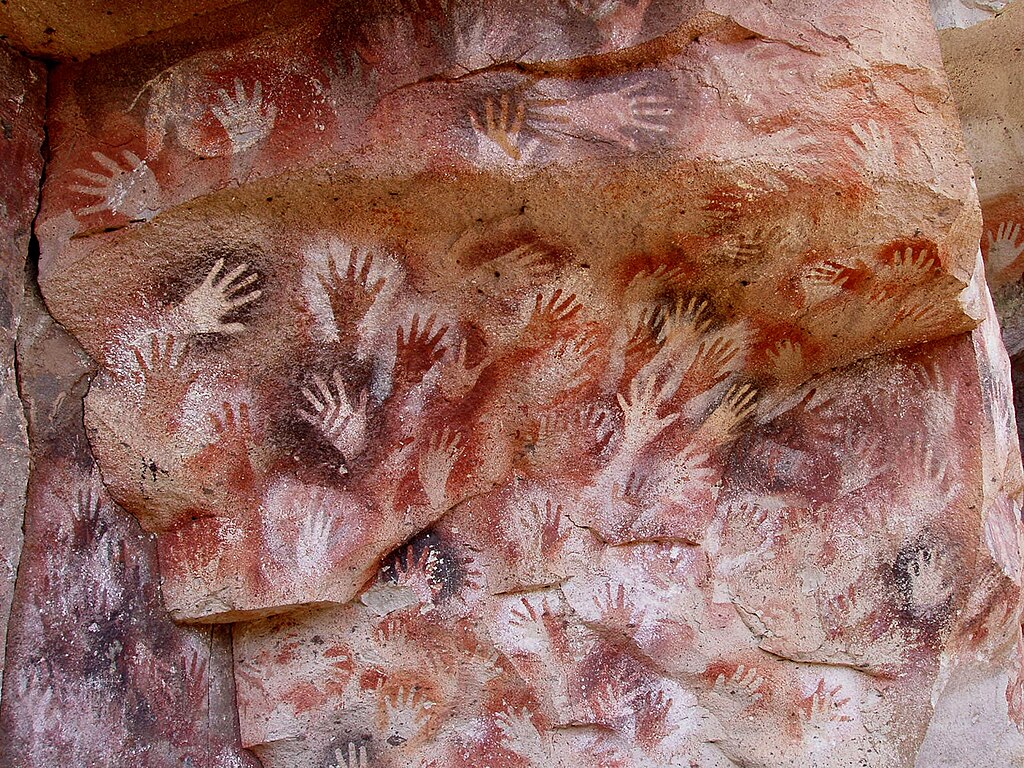Table of Contents - Jump to Section
Hand Symbolism in Brief
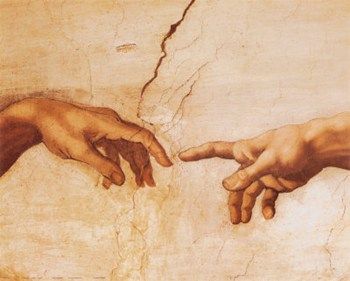 Amplifying hands symbolism reveals a rich tapestry of religious, cultural, and communicative significance woven through the ages. Our hands, those incredible extensions of ourselves, are far more than mere tools for grasping objects. They are complex instruments through which we express ourselves, convey our thoughts, and communicate in a language of gestures. Throughout the annals of human history, hands have held a remarkable role, carrying intricate messages, embodying potent concepts and profound cultural and spiritual significance.
Amplifying hands symbolism reveals a rich tapestry of religious, cultural, and communicative significance woven through the ages. Our hands, those incredible extensions of ourselves, are far more than mere tools for grasping objects. They are complex instruments through which we express ourselves, convey our thoughts, and communicate in a language of gestures. Throughout the annals of human history, hands have held a remarkable role, carrying intricate messages, embodying potent concepts and profound cultural and spiritual significance.
The hand, utilized as a power gesture, such as a fist, represents vigor and authority. The hands of a deity or a leader implies being subject to their influence, but it also conveys being safeguarded by them, as we see in the many images of the Christian Mary.
In everyday gestures, extending one’s hand(s) is indicative of a welcoming and receptive demeanor, as well as a display of dedication or forgiveness. Moreover, hands on the breast can symbolize a symbolic act of submission, and clasping hands with a lover or partner can signify marriage, friendship, and allegiance.
An Illustrated Encyclopedia of Traditional Symbols explains that a hand with three fingers or a mutilated hand symbolizes the phases of the moon. On the other hand, with all fingers extended, the hand is the sun’s rays, symbolizing the life-giving power from heaven or the sky. Sometimes the right hand is called the hand of power, while the left is associated with receptivity. Superstition associates the left hand with the devil, theft, or cheating.
The Symbolism of the Hand
Our hands are one of the most expressive parts of our body. Think of all the ways we communicate with our hands. Through them we can express joy, sorrow, fear, tension, quantity, number, or time. We clench our fists to make our demands known, to get ready to fight, or out of frustration or angst. Our hands signify power and strength, as well as blessing and submission.
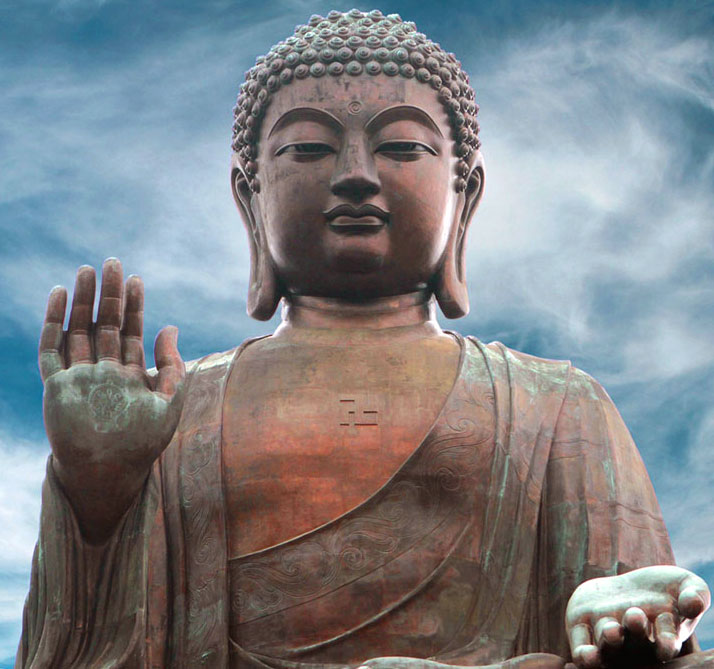
Tian Tan Buddha, Ngong Ping, Lantau Island, in Hong Kong
We speak of the Hand of God as divine power.
The Buddha holds his palm facing outward telling us, “Fear not,” while the other hand opens in a gesture of bestowing grace or unlimited giving. In some Buddhist iconography, the right hand of Buddha touches the earth. This indicates not only the inner strength to withstand the onslaught of fear, but also the attainment of the immovable point of enlightenment.
How a Hand Mudra Overcame Fear
The meaning of this symbolism is, “Fear not, you too have this strength.” It is not something outside of you. And neither is it an external power to whom you must submit. If you do not know the story of how Buddha attained his enlightenment, it is about overcoming our existential fears.
When Siddhartha Gautama sat under the Bodhi tree, he made a firm resolution not to rise until he had attained full enlightenment. As he meditated deeply, he was confronted by Mara, the deity symbolizing delusion, desire, and death in Buddhist cosmology. Mara recognized the threat Siddhartha posed to his dominion over beings ensnared by ignorance and desire. And so he tried various tactics to distract and deter Siddhartha from his path.
The Temptations
- Temptations by Mara’s Daughters: Mara first sent his three daughters – Desire (Tanhā), Discontent (Arati), and Delight (Raga) – to seduce Siddhartha. However, Siddhartha remained unmoved by their allure, his mind firmly rooted in meditation.
- Assault by Mara’s Armies: When seduction failed, Mara summoned his monstrous army to attack and intimidate Siddhartha. They launched a barrage of weapons at him, but as they approached Siddhartha, the weapons transformed into flowers, harmlessly falling around him.
- Challenge of Legitimacy: In a final attempt, Mara challenged Siddhartha’s right to occupy the seat of enlightenment, demanding a witness to attest to Siddhartha’s spiritual merits. In response, Siddhartha touched the earth with his right hand, calling upon the Earth Goddess to bear witness to his countless acts of merit accumulated over many lifetimes. The Earth Goddess responded by creating a tremendous roar, validating Siddhartha’s claim.
Having overcome Mara’s threats and challenges, Siddhartha continued his meditation throughout the night. As dawn approached, he attained full enlightenment, becoming the Buddha, which means “the awakened one.” The place of this significant event is present-day Bodh Gaya in India. The Bodhi tree under which he attained enlightenment became a revered pilgrimage site and symbol in Buddhism.
Now, lets’ bring it all together. In Buddhism, the serene and reassuring gestures of Buddha’s hand mudras often hold a deeper message – the path to overcoming fear. These symbolic hand gestures, such as the open palm facing outward, convey a message of “fear not.” They remind us that through inner peace and enlightenment, we can transcend our fears and anxieties, finding the courage to embrace life’s challenges with equanimity and grace.
Hand Symbolism in the Buddha’s Story
The position of Siddhartha Gautama’s hand during his enlightenment under the Bodhi tree is crucial in iconographic representations and bears symbolic significance in the story we explored in the Symbolism of the Snake.
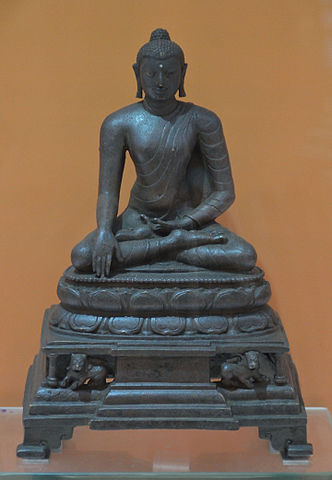 Bhumisparsha Mudra: As Mara challenged Siddhartha’s right to his seat of enlightenment and demanded a witness to attest to Siddhartha’s worthiness, Siddhartha responded by touching the earth with his right hand. This gesture, known as the Bhumisparsha mudra or “Earth Touching Gesture,” called upon the Earth Goddess to bear witness to his past merits. This mudra has become one of the most iconic representations of the Buddha. In statues and images of the Buddha, this pose symbolizes the moment of enlightenment and is depicted by the right hand reaching downwards, touching the earth.
Bhumisparsha Mudra: As Mara challenged Siddhartha’s right to his seat of enlightenment and demanded a witness to attest to Siddhartha’s worthiness, Siddhartha responded by touching the earth with his right hand. This gesture, known as the Bhumisparsha mudra or “Earth Touching Gesture,” called upon the Earth Goddess to bear witness to his past merits. This mudra has become one of the most iconic representations of the Buddha. In statues and images of the Buddha, this pose symbolizes the moment of enlightenment and is depicted by the right hand reaching downwards, touching the earth.
The gesture is symbolic of the Buddha’s connection to the earth, grounding, and the material world, even in his profound spiritual realization. It also emphasizes the significance of the Earth itself as a witness to this pivotal moment in his journey.
- Meditation Pose: While the Bhumisparsha mudra of the right hand is the most direct hand gesture in the story, the overall posture of Siddhartha during his meditation under the Bodhi tree also has significance. He is often depicted in the Dhyana mudra, where both hands lie on the lap, one over the other, palms facing upwards, symbolizing meditation, concentration, and the attainment of spiritual perfection.
The Message for Us About Buddh’s Hand Symbolism
Both hand gestures combined—Bhumisparsha and Dhyana—capture the essence of that transformative moment when Siddhartha Gautama, through deep meditation and unshakeable resolve, overcame Mara’s challenges and attained enlightenment.
Additionally, Buddhism offers the “touching the earth” mudra, a grounding gesture that can be particularly helpful during moments of anxiety. In this mudra, the fingers of one hand touch the ground, symbolizing a profound connection with the Earth and its stability. By grounding ourselves in this way, we can find solace and reassurance in the midst of turmoil, allowing the Earth’s unwavering presence to anchor us and provide a sense of security amid life’s uncertainties. It serves as a reminder that, like the Earth itself, we possess the inner strength to weather the storms of anxiety and emerge with renewed resilience.
Other Hand Mudras
In both Buddhism and Hinduism, the mudra represents a symbolic gesture primarily performed with the hands and fingers, signifying a spiritual gesture and energetic seal. The most familiar of these is Añjali Mudrā, prayer hands, meaning, “I salute the divinity within you.”
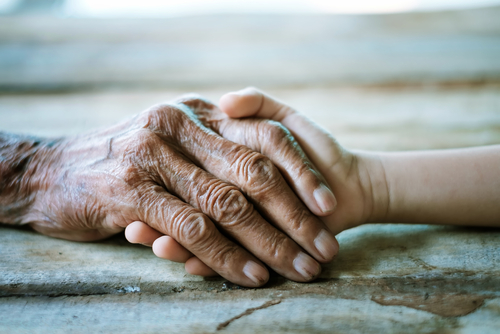 Hands brought together, palm upwards or on the lap, indicate meditation and receptiveness.
Hands brought together, palm upwards or on the lap, indicate meditation and receptiveness.
Hands joined in front of the heart represent the unity of Wisdom and Method.
“Wisdom” typically refers to the intellectual and insightful aspects of Buddhist practice, while “Method” represents the practical and compassionate aspects. When the hands are joined in this mudra, it signifies the harmonious integration of these two essential aspects of the spiritual path. It’s a reminder that wisdom and compassion should work together in a practitioner’s journey toward enlightenment and spiritual growth.
Symbolism of the hand in sayings and expressions
The symbolism of the hand is further exemplified through various sayings and expressions. Phrases like “our hands are tied” convey a sense of being bound or powerless. When things “get out of hand,” we have lost control. “Changing hands,” means passing over power or control. When we “wash our hands” of something, we absolve ourselves of responsibility or involvement. To experience something “first- hand” means to experience it directly.
We extend our hands to welcome someone or raise them to signal “Step back, proceed no further.” The laying on of hands can convey blessings or healing, while raising our hands can express adoration, devotion, amazement, or horror. Holding our palms up signifies ignorance or not knowing anything, while wringing our hands may denote grief or worry.
A disembodied hand can represent actions without conscience. The act of making something with your hands could indicate a call do so more often in life. “Getting your hands dirty” means having a richer experience as a result of throwing yourself fully into something.
Symbolism of the Hand Across Cultures
Celtic Hand Symbolism
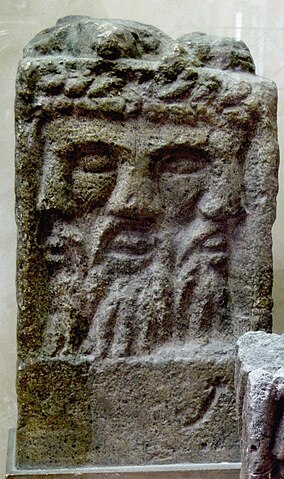 In Celtic mythology, Lugh Lamfada is a prominent god associated with light, craftsmanship, and various skills. Lamfada means “of the long arm” or “long hand” in Old Irish. This epithet, “long hand,” is rich in symbolic meaning and has been interpreted in various ways.
In Celtic mythology, Lugh Lamfada is a prominent god associated with light, craftsmanship, and various skills. Lamfada means “of the long arm” or “long hand” in Old Irish. This epithet, “long hand,” is rich in symbolic meaning and has been interpreted in various ways.
One of the interpretations connects Lugh’s “long hand” to the rays of the sun. Given that Lugh is often linked to light and the sun, this association is fitting. The extended reach of his hand, or its radiance, symbolizes the far-reaching rays of the sun, illuminating the world and bringing life, warmth, and energy. This imagery aligns with Lugh’s role as a solar deity, representing the power, consistency, and encompassing nature of the sun.
Additionally, Lugh’s multifaceted abilities in arts, crafts, and war further emphasize the idea of his “long hand” reaching into many areas of expertise, just as the sun’s rays touch upon everything in the world.
Chinese Hands Symbolism
Interlocking hands symbolize camaraderie and loyalty. Hiding the hands is a gesture of reverence and humility. The right hand represents yang, symbolizing power, contrasting the left hand which signifies honor. However, during wartime, the right hand is seen as the hand of honor because it wields the sword. The left hand, embodying yin, is perceived as the gentler side, symbolizing respect and distinction, as excessive strength can give rise to conflict and ruin.
Christian:
In Christian imagery, a hand emerging from a cloud symbolizes God the Father’s presence and might, occasionally releasing the Dove, representing the Holy Spirit. A hand raised with the palm facing out signifies blessings, divine mercy, and favor. When three fingers are lifted, it represents the Holy Trinity. If the entire hand is raised, the thumb stands for the Father, the first finger for the Holy Spirit, the second for Christ, and the last two fingers signify Christ’s dual nature. The act of laying hands during Confirmation denotes the imparting of the Spirit’s power and grace. A hand clutching a money pouch is symbolic of Judas Iscariot.
Egyptian:
In Egyptian symbolism, the ‘hand of the Egyptians’ illustrates the harmony of fire and water, or the masculine and feminine energies. The word for “hand” shares connections with terms denoting a pillar (symbolizing support or strength) and the palm. In esoteric teachings, the hand’s position relative to the body and the configuration of the fingers communicate specific symbolic meanings. In the Egyptian hieroglyphic system, the hand symbolizes concepts of manifestation, activity, and giving.
The outstretched hand often represents uniquely human endeavors as well as a magnetic energy, a notion also observed in pre-Columbian American cultures. This idea aligns closely with the prevalent use of the hand as a protective talisman in Islamic societies. In Berber philosophy, the hand denotes safeguarding, dominion, potency, and fortitude. For the Romans, the “manus” bore a similar symbolism, particularly emphasizing the authority of the family patriarch and the emperor. Occasionally, it replaced the imperial eagle atop the “signum” of the Roman legions.
Greek Symbolism of the Hand
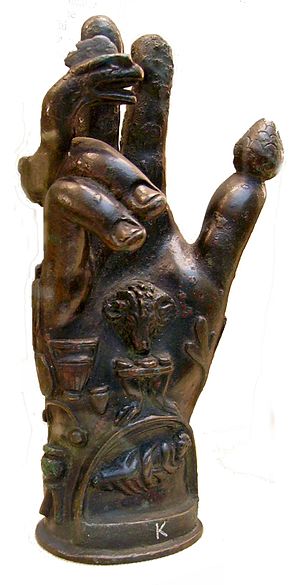 The votive Hand of Sabazios has the thumb and first finger extended, with the third and fourth fingers crooked (the Cornuto), and has on it the cone, snake, cross, crescent, caduceus, lizard, insects. It suggests the helping hand of the god, or protection, healing and blessing, or that the three fingers are the triad or male trinity, or that it is merely talismanic and apotropaic.
The votive Hand of Sabazios has the thumb and first finger extended, with the third and fourth fingers crooked (the Cornuto), and has on it the cone, snake, cross, crescent, caduceus, lizard, insects. It suggests the helping hand of the god, or protection, healing and blessing, or that the three fingers are the triad or male trinity, or that it is merely talismanic and apotropaic.
Hindu:
With the hands of Siva, the uplifted hand is peace and protection, the lowered hand, pointing to the foot, depicts deliverance, the drum beat is the creative act and the flame in the hand denotes the destruction of the world by fire.
Hand Symbolism in the Goddess Kali
- Destructive Power & Creation: Kali is a goddess of both destruction and creation. One of her hands typically holds a sword, symbolizing her power to cut through delusions and ego, while another hand holds a severed head, indicating the detachment from the unreal or the ego’s death. These elements highlight her destructive nature, which is necessary for rebirth and creation.
- Blessings & Assurance: Kali’s other hands are usually in the “abhaya” (fear not) and “varada” (blessing) mudras. The abhaya mudra represents protection, peace, and dispelling of fear, while the varada mudra symbolizes the bestowing of boons. These gestures signify that while she may seem fierce and terrifying, she is also a protective mother figure, bestowing blessings upon her devotees.
- Duality: The combination of her destructive and benevolent symbols signifies the inherent duality of existence. Life is a blend of creation and destruction, and Kali embodies this balance.
- Cycle of Life: The severed head and the sword, when combined with her other peaceful mudras, depict the complete cycle of life, from birth to death to rebirth, showing that everything is a part of the divine play or “lila”.
In essence, the hands in Kali’s depictions are not just mere appendages but profound symbols of her nature, role in the cosmic order, and her relationship with her devotees.
Hand Symbolism: Nataraja
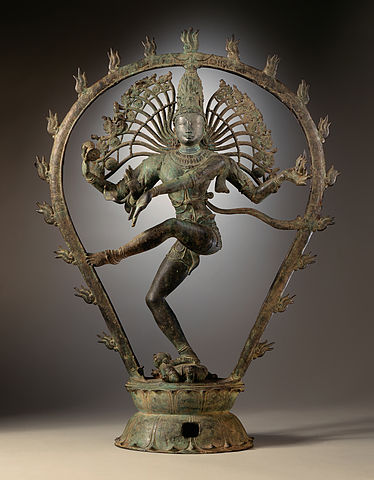 The Nataraja, or the “Lord of Dance,” is one of the most iconic representations of the Hindu god Shiva. In this form, Shiva is depicted performing the Tandava, the cosmic dance through which he both creates and destroys the universe.
The Nataraja, or the “Lord of Dance,” is one of the most iconic representations of the Hindu god Shiva. In this form, Shiva is depicted performing the Tandava, the cosmic dance through which he both creates and destroys the universe.
Upper Right Hand
Holds the damaru, a small drum shaped like an hourglass. The sound of this drum symbolizes the primordial sound of creation and origin of the spoken language. This hand represents the creative aspect of the cosmic dance.
Upper Left Hand
Holds a flame, the Agni. This flame represents destruction, but it’s also a purifying force. The idea is that everything in the cosmos is cyclical; after destruction comes creation, and vice versa. This hand represents the destructive aspect of the cosmic dance.
Lower Right Hand
Positioned in Abhaya Mudra, which is a gesture of protection, assurance, and blessing. It symbolizes fearlessness and protection to the devotees against all negative forces. This hand represents refuge and assurance.
Lower Left Hand
Points down to the lifted foot with the palm facing outwards. This is the gahahasta or elephant trunk hand pose. This gesture is symbolic of the path of salvation and grace.
Symbolic Amplifications for Life
The damaru and the Agni in Shiva’s hands represent the cyclical nature of creation and destruction.
Just as there are natural cycles of growth and decay in the universe, our lives too are marked by periods of growth and setbacks. Embracing this can help us understand that challenges or “destructions” are often precursors to new beginnings or “creations.” Just like a forest that grows back more robust after a fire, personal challenges can lead to growth and transformation.
The Abhaya Mudra signifies protection, assurance, and blessings. In our daily lives, this can be a reminder to face challenges with courage and confidence. As with the Buddha’s hand gestures, knowing that we have the inner strength and the universe (or a higher power, if one believes in it) is protecting us, we can confront fears and obstacles with assurance.
3. The Path of Salvation and Grace
Symbolism: The pointing of the lower left hand towards the lifted foot signifies the path of salvation and grace.
Application: It serves as a reminder that through introspection, self-awareness, and righteous action, we can rise above worldly attachments and achieve inner peace and spiritual growth.
Symbolism of the Hand: The Left Hand Path
In Hindu culture the left hand-path is the way of inner realization. We can read more from Joseph’s Campbell’s Creative Mythology,
The rose garden of the philosophers, then, is to be entered by the left hand path. The left hand path is the way, then, of a passage by way of the senses–the eyes, the heart, and spontaneity of the body–to a realization and manifestation “at the still point of the turning world,” in act and experience on earth, of the radiance, harmony, bounty and joy of nature.
The left, the side of the heart, the shield side, has been symbolic, traditionally and everywhere, of feeling, mercy and love, vulnerability and defenselessness, the feminine virtues and dangers: mothering and seduction, the tidal powers of the moon and substances of the body, the rhythms of the seasons: gestations, birth, nourishment, and fosterage; yet equally malice and revenge, unreason, dark and terrible wrath, black magic, poisons, sorcery and delusion; but also fair enchantment, beauty, rapture and bliss.
And the right, thereby is of the male: action, weapons, hero-deeds, protection, brute force, and both cruel and benevolent justice; the masculine virtues and dangers: egoism and aggression, lucid luminous reason, sunlike creative power, but also cold unfeeling malice, abstract spirituality, blind courage, theoretical dedication, sober, unplayful moral force.
Hamsa
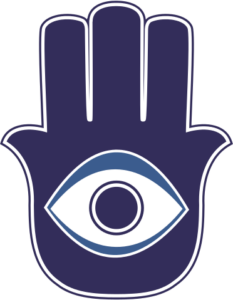 The Talismanic Hand portrayed with the eye and other power symbols typifies clairvoyance and the psychic power it confers. The hand symbolizes the helping hand of compassion and wisdom which is not blind but discriminating.
The Talismanic Hand portrayed with the eye and other power symbols typifies clairvoyance and the psychic power it confers. The hand symbolizes the helping hand of compassion and wisdom which is not blind but discriminating.
The Symbolism of the Hand in Film
A disembodied hand symbolizes acting without conscience.
In the film “The Hand,” the main character, Jon, loses his hand in a car accident. As he struggles to cope, his severed hand takes on a life of its own, committing violent and murderous acts.
The detached, malevolent hand symbolizes actions, when divorced from our rational and moral faculties, can lead to destructive consequences. Jon’s hand, acting independently, becomes a symbol of his inner turmoil and descent into madness. It represents a loss of control over his own actions and an inability to rein in his darker impulses.
In the context of hand symbolism, the hand’s actions in the film can be seen as a metaphor for the consequences of unchecked desires and impulses. It serves as a cautionary tale about the importance of self-awareness and the potential dangers of acting without conscience.
Overall, “The Hand” uses the symbolism of a disembodied hand to explore themes of psychological turmoil, loss of control, and the consequences of unchecked actions, aligning with the idea that a disembodied hand represents acting without conscience.
Hand Symbolism Final Thoughts
As we navigate the modern world, hand symbolism continues to evolve, finding new meanings in the digital age. Yet, the simple act of extending a hand in friendship or touching earth mudra for grounding during anxiety still carries profound meaning and connection. Ultimately, our hands remind us of the enduring power of human communication and culture, and the importance of acting with consciousness and compassion, lest we risk letting our actions become like a disembodied hand, acting without conscience.
- How to Remember Dreams - October 22, 2023
- The Power and Mystique of Hand Symbolism - October 14, 2023
- Lion Symbolism and Lion Dreams - October 10, 2023
Share this Post
